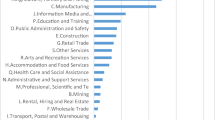Abstract
This paper analyses the performance of the small and medium-sized manufacturing firms during the period 1995–2001, focusing on the degree of technical inefficiency and its determinants. We use a micro panel data set to simultaneously estimate a stochastic frontier production function and the inefficiency determinants using an unbalanced panel of manufacturing firms. Our empirical results suggest that small and medium-sized firms tend to be less inefficient than the large firms are. Also, we centre our analysis in the effect on efficiency of some organisational factors related to the managerial ability to use and adjust capital and labour properly.

Similar content being viewed by others
Notes
Specially, sectors such as banking, agriculture, transport and electricity industries, hospitals and other non-profit sectors, see Lovell (1993) for a good survey of the frontier approach.
In a two-stage procedure, first of all a stochastic frontier production function is estimated and the inefficiency scores are obtained under the assumption of independently and identically distributed inefficiency effects. But in the second step, inefficiency effects are assumed to be a function of some firm-specific variables, which contradicts the assumption of identically distributed inefficiency effects.
Individual efficiency scores ui, which are unobservable, can be predicted by the mean or the mode of the conditional distribution of ui given the value of (vi−ui) using the technique suggested by Jondrow et al (1982).
We imposed the usual symmetry conditions to the translog function: βkj = βjk; j ≠ k.
LR = −2(ln[L(H0)]−ln[L(H1)](, where L(H0) and L(H1) are the values of the likelihood function under the null and alternative hypotheses. LR has an approximately χ 2 distribution with degrees of freedom equal to the number of restrictions.
References
Aigner, D., Lovell, K., & Schmidt, P. (1977). Formulation and estimation of stochastic frontier production function models. Journal of Econometrics, 6, 21–37.
Amuedo-Dorantes, C. (2001). From temp to perm, promoting permanent employment in Spain. International Journal of Manpower, 22(7), 625–647.
Battese, G. E., & Coelli, T. J. (1995). A model for technical inefficiency effects in a stochastic frontier production function for panel data. Empirical Economics, 20, 325–332.
Caves, R. E., & Barton, D. R. (1990). Efficiency in US manufacturing industries. Cambridge, MA: MIT Press.
Caves, R. E., et al. (1992). Industrial efficiency in six nations. Cambridge, MA: MIT Press.
Coelli, T. (1996). A guide to FRONTIER Version 4.1: A computer program for stochastic frontier production and cost function estimation. CEPA Working Paper 96/07 University of New England.
Delgado, M., Fariñas, J. C., & Ruano, S. (2002). Firms productivity and export markets: a non-parametric approach. Journal of International Economics, 57, 397–422.
Díaz-Mayans, M. A., & Sánchez, R. (2004). Temporary employment and technical efficiency in Spain. International Journal of Manpower, 25(2), 181–194.
Dilling-Hansen, M., Madsen, E. S., & Smith, V. (2003). Efficiency, R&D and ownership-some empirical evidence. International Journal of Production Economics, 83, 85–94.
Dolado, J. J., Garcia-Serrano, C., & Jimeno, J. F. (2002). Drawing lessons from the boom of temporary jobs in Spain. The Economic Journal, 112, 270–295.
Fariñas, J. C., & Jaumandreu, J. (1999). Diez años de encuesta sobre estrategias empresariales (ESEE). Economía Industrial, 329, 29–42.
Fariñas, J. C., & Ruano, S. (2004). The dynamics of productivity: A decomposition approach using distribution functions. Small Business Economics, 22, 237–251.
Farrell, M. J. (1957). The measurement of productive efficiency. Journal of Royal Statistical Society, 120, 251–281.
Green, A., & Mayes, D. G. (1991). Technical efficiency in manufacturing industries. The Economic Journal, 101, 523–538.
Güell, M., & Petrongolo, B. (2000). Workers transitions from temporary to permanent employment: the Spanish case. CEP, Discussion Paper 438.
Gugler, K. (2001). Corporate governance and economic performance. Oxford: Oxford University Press.
Gumbau, M. (1998). La eficiencia técnica de la industria española. Revista Española de Economía, 15(1), 67–84.
Gumbau, M., & Maudos, J. (2002). The determinants of efficiency: The case of the Spanish industry. Applied Economics, 34, 1941–1948.
Hay, D., & Liu, G. (1997). The efficiency of firms: What difference does competition make? The Economic journal, 107, 597–617.
Huergo, E., & Jaumandreu, J. (2004). How does probability of innovation change with firm age. Small Business Economics, 22, 193–207.
Jondrow, J., Lovell, K., Materov, I. S., & Schmidt, P. (1982). On the estimation of technical inefficiency in the stochastic frontier production function model. Journal of Econometrics, 19, 233–238.
Kodde, D., & Palm, F. (1986). Wald criteria for jointly testing equality and inequality restrictions. Econometrica, 54(5), 1243–1248.
Lovell, K. (1993). Production frontiers and productive efficiency. In HO. Fried, CAK. Lovell & SS. Schmidt (Eds.), The measurement of productive efficiency: Techniques and applications. Oxford: Oxford University Press.
Martin-Marcos, A, & Suárez-Galvez, C. (2000). Technical efficiency of Spanish manufacturing firms: A panel data approach. Applied Economics, 32, 1249–1258.
Nickell, S., Nicolitsas, D., & Dryden, N. (1997). What makes firms perform well? European Economic Review, 41, 783–796.
Patibandla, M. (1998). Structure, organizational behaviour, and technical efficiency: The case of an Indian industry. Journal of Economic Behaviour and Organization, 34, 419–434.
Short, H. (1994). Ownership, control, financial structure and the performance of firms. Journal of Economic Surveys, 8, 203–249.
Acknowledgments
The authors wish to express their gratitude to the participants of the International Conference on Policy Modeling (2006) for their useful comments. The authors would also like to thank the Fundación Empresa Pública (FEP), especially the economics research programme (PIE), for providing the data source. The study has been supported by the projects of Science and Technology GV04B-086 and SEJ2005-08054.
Author information
Authors and Affiliations
Corresponding author
Rights and permissions
About this article
Cite this article
Diaz, M.A., Sanchez, R. Firm size and productivity in Spain: a stochastic frontier analysis. Small Bus Econ 30, 315–323 (2008). https://doi.org/10.1007/s11187-007-9058-x
Received:
Accepted:
Published:
Issue Date:
DOI: https://doi.org/10.1007/s11187-007-9058-x




